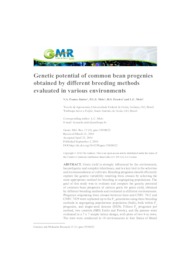Genetic potential of common bean progenies obtained by different breeding methods evaluated in various environments.
Genetic potential of common bean progenies obtained by different breeding methods evaluated in various environments.
Author(s): PONTES JUNIOR, V. A.; MELO, P. G. S.; PEREIRA, H. S.; MELO, L. C.
Summary: Grain yield is strongly influenced by the environment, has polygenic and complex inheritance, and is a key trait in the selection and recommendation of cultivars. Breeding programs should efficiently explore the genetic variability resulting from crosses by selecting the most appropriate method for breeding in segregating populations. The goal of this study was to evaluate and compare the genetic potential of common bean progenies of carioca grain for grain yield, obtained by different breeding methods and evaluated in different environments. Progenies originating from crosses between lines and CNFC 7812 and CNFC 7829 were replanted up to the F-7 generation using three breeding methods in segregating populations: population (bulk), bulk within F-2 progenies, and single-seed descent (SSD). Fifteen F-8 progenies per method, two controls (BRS Estilo and Perola), and the parents were evaluated in a 7 x 7 simple lattice design, with plots of two 4-m rows. The tests were conducted in 10 environments in four States of Brazil and in three growing seasons in 2009 and 2010. Genetic parameters including genetic variance, heritability, variance of interaction, and expected selection gain were estimated. Genetic variability among progenies and the effect of progeny-environment interactions were determined for the three methods. The breeding methods differed significantly due to the effects of sampling procedures on the progenies and due to natural selection, which mainly affected the bulk method. The SSD and bulk methods provided populations with better estimates of genetic parameters and more stable progenies that were less affected by interaction with the environment.
Publication year: 2016
Types of publication: Journal article
Unit: Embrapa Rice & Beans
Observation
Some of Embrapa's publications are published as ePub files. To read them, use or download one of the following free software options to your computer or mobile device. Android: Google Play Books; IOS: iBooks; Windows and Linux: Calibre.
Access other publications
Access the Agricultural Research Database (BDPA) to consult Embrapa's full library collection and records.
Visit Embrapa Bookstore to purchase books and other publications sold by Embrapa.

